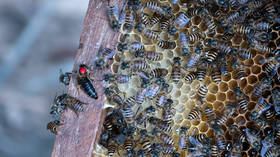On the Origin of Feces: Bees observed using animal dung as defensive tool against giant hornets in scientific first

Researchers have witnessed what they suspect is the first instance of wild bees using tools, after observing Asian honeybees gathering animal feces to ward off attacks by giant hornets.
Throughout the region, the Asian honeybee (Apis cerana) is preyed upon by a species of giant hornet (Vespa soror) – closely related to the murder hornet which invaded the US over the summer.
In a new study on bee hives in Vietnam, researchers observed worker bees collecting fresh animal dung and smearing it on the exterior of their nest to dissuade the hornets from wiping them out.
Researchers introduced either live hornets or their chemical ‘scent’ to an area and, shortly after, the resident honeybees rushed to gather up as much dung, from whatever source, as they could and daub it on their nests for several days.
It remains unclear (scientifically speaking) exactly how the dung protects the colony, but given that the hornets chew through the nest itself during their attacks, a few theories might spring to mind.
“We argue that A. cerana forages for animal feces because it has properties that repel this deadly predator from nest entrances, providing the first report of tool use by honeybees and the first evidence that they forage for solids that are not derived from plants,” the researchers write.
Also on rt.com Scientists turn bee guts into medicine factories to FIGHT OFF deadly pathogensThey claim it is the first time bees have been observed using tools outside of a laboratory context. Though bees are known to collect plant material to build their nests, there is apparent disagreement among the scientific community about whether this constitutes tool use.
A widely accepted definition is that a tool is an object found externally which is worked upon to give it a defined purpose. The technique of daubing other animals’ dung on the bees’ nest, known as ‘fecal spotting’, fits this definition, though in a rather distasteful way.
The giant hornet is a fearsome predator and poses a major threat to the humble honeybee as a single insect can kill thousands of bees single-handedly in a matter of hours, thanks to their thick armor.
The weaponized waste ranks number two among a number of sophisticated defense techniques deployed by the bees, however. Their main method is to swarm and surround the invader before vibrating enough to generate heat and slowly cook the invasive insect.
The bees were also observed performing what were described as “emergency dances” outside the nests to distract attacking hornets while other workers continued smearing feces around the entrance.
Curiously, attacks by other smaller and far less deadly hornets did not trigger this waste management response.
Scientists suspect the feces may contain chemicals that mask the location of the nest, affording it a rather unsettling form of camouflage from scouting giant hornets, but requires too much time and resources to deploy during every attack. The bees instead reserve the ‘dung defense’ for their mortal enemy, Vespa soror.
Think your friends would be interested? Share this story!













